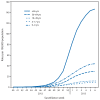Update: Influenza activity - United States, September 30, 2012-February 9, 2013
- PMID: 23425961
- PMCID: PMC4604885
Update: Influenza activity - United States, September 30, 2012-February 9, 2013
Abstract
Influenza activity in the United States began to increase in mid-November and remained elevated through February 9, 2013. During that time, influenza A (H3N2) viruses predominated overall, followed by influenza B viruses. This report summarizes U.S. influenza activity* since the beginning of the 2012-13 influenza season and updates the previous summary.
Figures




References
-
- CDC. Update: influenza activity—United States, September 30–November 24, 2012. MMWR. 2012;61:990–3. - PubMed
-
- CDC. Prevention and control of influenza with vaccines: recommendations of the Advisory Committee on Immunization Practices (ACIP) MMWR. 2010;59(RR-8) - PubMed
-
- Dao CN, Kamimoto L, Nowell M, et al. Adult hospitalizations for laboratory-positive influenza during the 2005–2006 through 2007–2008 seasons in the United States. J Infect Dis. 2010;202:881–8. - PubMed
-
- Thompson WW, Shay DK, Weintrab E, et al. Mortality associated with influenza and respiratory syncytial virus in the United States. JAMA. 2003;289:179–86. - PubMed
MeSH terms
Substances
LinkOut - more resources
Full Text Sources
Medical

